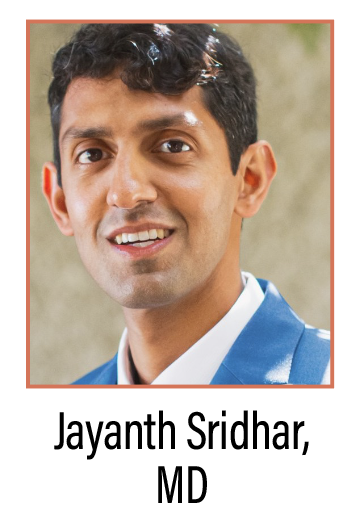 |
|
Bio Dr. Sridhar serves as Retina Specialist Magazine’s Social Media Ambassador. He’s an associate professor of clinical ophthalmology at Bascom Palmer Eye Institute, Miami. DISCLOSURE: Dr. Sridhar is a consultant to Alcon, DORC, Genentech/Roche and Regeneron Pharmaceuticals. |
Social media and modern personal electronic devices have transformed the way we interact, learn and share. Still, it has become increasingly apparent that a strong correlation between social media usage and mood changes exists.
This is most obvious in adolescents. A 2017 study reported that from 2010 to 2015, the suicide rate for eighth- through 12th- grade girls rose 65 percent, correlating with the exponential year-by-year rise in smartphone usage.1 One proposed reason has been worsening feelings of isolation. A University of Pennsylvania study found that high use of Instagram, Snapchat and Facebook increased feelings of loneliness among college undergraduates.2
Other possible underlying causes include impacts on healthy sleep habits, substitution for healthier activities such as physical exercise, disrupted concentration, fear of missing out (FOMO) and reductions in self-esteem.
To this last point, social media can give the user the false impression that everyone else is having a grand time without any troubles or worries. We’ll see photos of exotic vacations, perfect babies and once-in-a-lifetime experiences, and few, if any, depictions of sad, awkward or contentious moments.
How it translates to the world of retina
To translate this to the world of retina, Twitter and LinkedIn have become hubs for academic connection and clinical demonstration of excellence. At times, the extraordinary publications and brilliant surgical outcomes our colleagues present on these platforms can give the reader discomfiting feelings of inadequacy. A purported five-minute check in before bed can turn into an hour-long spiral into insecurity.
While true security ultimately comes from within, I would argue that we all share a responsibility to professionally use social media not only for the betterment and advancement of ourselves, but also for the betterment of all retina doctors so that we may rise together.
Thus, it may be conducive to be mindful of balancing positive and sweeping social media posts with more humble and realistic ones. Like morbidity and mortality conferences and “complications sessions” at retina meetings, discussing our day-to-day as academicians and retinal specialists more realistically allows us to be more vulnerable with one another to ultimately foster self-
improvement as a group.
Good examples on the academic side would be discussing “how the sausage gets made.” This could include how long it takes to get a research project off the ground, any setbacks encountered while collecting data, the number of internal and external revisions required prior to academic publication and rejections from academic journals and meetings—not in a tone of complaint, but rather of humility.
A more balanced approach
From the clinical side, we should feel more comfortable discussing medical and surgical cases that don’t end up with the best possible outcome. Of course, we would need to be HIPAA-compliant and/or get consent (just like with any other public social media post).
And in cases with worse outcomes, a prudent retina doctor must always be mindful of potential legal liability and malpractice suits. In the end, we all want to create and read positive content. For our own mental health as clinicians, surgeons and scientists, let’s just make sure it’s not too positive. RS
REFERENCES
1. Twenge JM, Joiner TE, Rogers ML, Martin GN. Increases in depressive symptoms, suicide-related outcomes, and suicide rates among U.S. adolescents after 2010 and links to increased new media screen time. Clin Psych Sci. 2018;6:3-17.
2. Hunt MG, Marx R, Lipson C, Young J. No more FOMO: Limiting social media decreases loneliness and depression. J Soc Clin Psych. 2018;10: doi.org/10.1521/jscp.2018.37.10.751.



